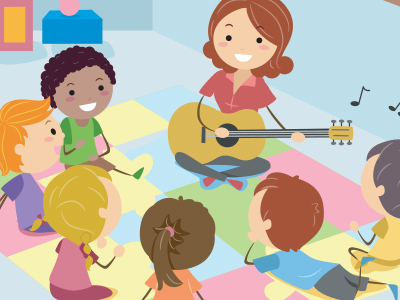
Music In Bloom
Wonder and Surprise
by Maureen Conlin
Music is in bloom this fall as young children blossom and grow through the songs they sing each day. When we as early childhood music educators provide children with age-appropriate songs that encourage them to sing together, make up their own lyrics, or move to the music, we spur their growth in so many areas of development. We inspire those young minds when we “sing like nobody’s listening,” explore different instruments, and share songs that teach them about science, math, language, history, and art. When children sing, they sing for us all.
There are many resources for parents and early childhood educators to help make this possible for young children. The Children’s Music Network is one of those wonderful resources. Often a member will share a simple song through the listserv or on Facebook, and that song will take flight into many creative directions. A member will write a simple song about a bunny; you share it and encourage children to hop to the music, and before you know it, a three- or four-year-old is suggesting they should be frogs or fish or wiggly worms, and the song morphs into something wonderful and new.
Providing young children with a variety of different rhythm instruments and letting them explore the different sounds opens a pathway to learning that extends into a steady beat or simple rhythm patterns. Sharing with children the appropriate way to handle the rhythm instruments is also important. Start with egg shakers so they understand that instruments can be fragile or broken like an egg when they bang them together or on the floor: “They are shakers not breakers.”
Use a simple verse to encourage exploration such as:
Found sounds, found sounds,
Sounds are everywhere
Found sounds, found sounds,
Listen you will hear.
While children sit in a circle, invite each child take a turn to share the sounds that they find playing their rhythm instrument.
When we hear children singing together, those voices reflect the wonder and innocence that is so delightfully unique in children. When a child makes up a song or melody, expresses different emotions when they sing, or acts out a song, it is a very special gift for the listener. Again, they are singing for us all.
Provide opportunities for children to:
- Make up their own songs
- Express emotion
- Use body and mind together to integrate movement with music and song
Three- and four-year-olds have very creative imaginations, and when they make up songs, all sorts of new characters are born. Children can become dinosaurs, such as a Johnasaurus or a Caitlynadactile. Maybe even a Tenzinadon. Then they stomp their feet and tell you in the song how they move through the forest or in a cave.
Johnasaurus moves like this (child creates a movement to go with
his dinosaur name),
His thorny tail goes swish, swish, swish.
The Caitlynadactile moves to and fro (child creates a movement),
Watch her twirl and watch her go.
But Keishatops can really roar,
’Cause she’s a happy dinosaur.
Children can sing up and down the C major scale using animal sounds to explore the highs and lows in their voices. Guide them to sing going up the C major scale using these lyrics:
“C” there is a cat, “D” there is a dog
“E” an elephant, and “F” I hear a frog
“G” is a giraffe, and “A” an alligator
“B” a big brown bear, and now I’ll see you later.
Children can sing down the C major scale using animal sounds such as a cow, a cat, or any animal that they want to mimic.
Provide an activity for children to listen to one another. If they are shy and feeling a little inhibited about getting up in front of a group of other children, ask them to choose a singing partner to join them. Ask them to sing one of their favorite songs or play the game using a shoe box with several slots in the top and craft sticks placed into the slots. On one end of the stick is written the name of a simple song the child can sing or a sticker that might represent a song, such as a dog for “BINGO” or a farm animal for “Old MacDonald had a Farm.” Each child pulls out a stick, then sings whatever song they think the sticker or picture represents.
Let your own imagination fly with this one as you come up with ideas for what goes on the craft stick, and watch how much fun it is to see how the children interpret it.
I leave you with this verse and encourage you to continue guiding children on their musical journey.
Singing for us all are the children we see each day
Listen to those voices as they take flight and fly away
The joyous sound we hear that makes our spirits rise
As children blossom and bloom in wonder and surprise.
Tell us how you’ve been making children blossom and bloom in your classroom! Email Maureen at happynotes@aol.com with comments or column ideas.